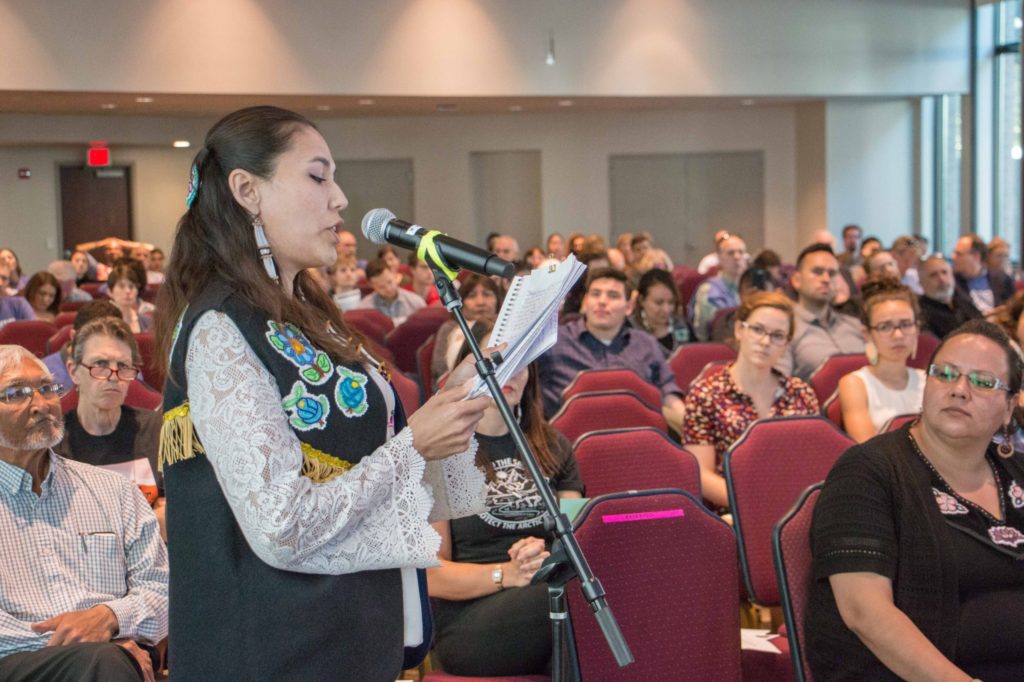Though the creation of the Arctic Range in 1960 is remembered as the work of mainstream American environmental groups, the Gwich’in have always been stewards and protectors of the Sacred Place Where Life Begins. Even in the early years of the Arctic Range, the Gwich’in began to exercise their opposition to drilling through the American political system. In 1964, Gwich’in leaders formed Gwitchya Gwitchin Ginkhye (Yukon Flats People Speak) to oppose to the Rampart Dam proposal. They were successful in defeating the proposal, saving seven Gwich’in villages that would have been flooded by the project. In the 1970s, Thomas Berger captured the concerns and anger of the Gwich’in in a report on the proposed Mackenzie Valley Pipeline, leading the Canadian government to abandon the project years later.
Increased interest in drilling in the 1980s galvanized the Gwich’in to take further action to defend their homeland. In the summer of 1988, they gathered in Arctic Village, Alaska for Gwich’in Niintsyaa, “a gathering of the people.” The protection of the Arctic Refuge was a key theme at the gathering, which inspired an immediate wave of activism by Gwich’in individuals, like Jonathan Solomon, who testified before Congress in opposition to Arctic drilling, and Adeline Raboff, whose writing appeared in the New York Times. But for many, the Niintsyaa is also remembered as the rebirth of the Gwich’in nation, culminating in the creation of the Gwich’in Steering Committee (GSC). At its founding, the GSC adopted that included a commitment to defense of the Arctic Refuge, which the committee has pursued by producing important campaign materials and environmental reports and through other means since its creaiton.
Along with other, the GSC has also played a key role in supporting the Last Great Wilderness slide show by recruiting Gwich’in representatives to tour with it. In fact, though produced and coordinated by non-Indigenous activists like Kohm, much of the success of the LGW is due the personal experience that Gwich’in spokespeople like Norma Kassi brought to show, allowing audiences to connect to the issue on a deeper emotional level. Indeed, Gwich’in activists have considered the LGW to be a key part of their Refuge defense strategy.
Though key Gwich’in activists have been recognized for their role in protecting the Arctic Refuge, other Alaska native nations and communities have been vocal opponents of fossil fuel extraction in the Arctic. Organizations like Gwich’in and Iñupiat-led Resisting Oil Extraction on Indigenous Lands (REDOIL), a key opponent in the defeat of Shell’s plan to open new wells off the northern coast of Alaska in the early 2010s, have coordinated the efforts of different Alaska native communities to protect their lands from fossil fuel extraction.
In recent years, this cooperation has developed into a full-fledged Indigenous-led movement for a just transition to clean energy in Alaska and beyond. Indigenous leaders like Chief Dana Tizya-Tramm of the Vuntut Gwitchin First Nation are taking a central role in environmental coalitions committed to the task. Opposition to drilling by Alaska natives has also moved to new platforms and realms of political action. Some, like Sam Alexander of the Gwich’in Council International, have continued to speak directly to federal policymakers. Others have worked with progressive media outlets like Al-Jazeera and truthout.org to spread their message among an increasingly online activist audience. Others have made use of different media, including filmmaking and podcasting, to expand their reach.

